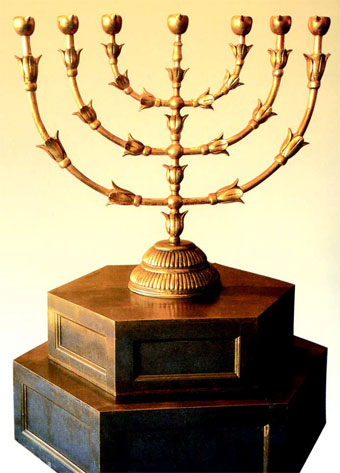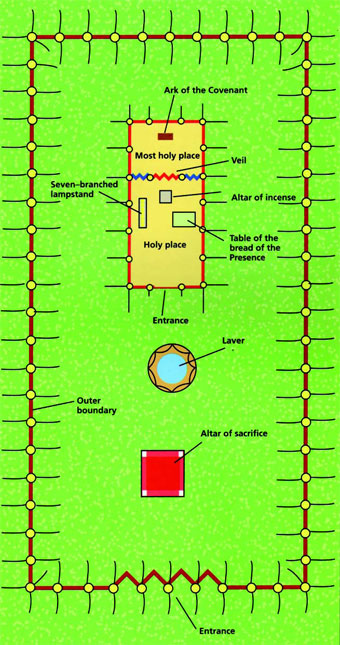
March 2009
From the editor: "Here am I"
J Grant
A Series of Letters on Bible Study (8): Studying Narrative (ii)
D Newell
New Testament Evangelism (4)
J Hay
Studies in the Book of Ruth (3)
I Steele
Seven ways in which the local assembly is related to God (1)
H A Barnes
Christ is all and in all (2)
M C Davis
Notebook: Introduction To The Tabernacle (6)
J Grant
The Upper Room Ministry (8)
C Jones
Whose faith follow: Mr James Anderson (1925-1992)
A Gamble
Into All The World: Camundambala School, Angola
Ruth Hadley
Christian Perspective
A Borland


After coming in at the gate and passing the Brazen Altar and the Laver, the priest would enter by the door into the Holy Place. In that chamber was to be found the Table of Shewbread, the Golden Altar, and the Lampstand. Beyond that there was the Holiest of All, separated from the Holy Place by the Vail. Only the High Priest could proceed there and that only once each year on the Day of Atonement (Lev 16).
The purpose of the Lampstand was to provide light in the Holy Place, and it was placed on the south side, directly opposite the Table of Shewbread. To maintain this light the people were instructed to bring "pure oil olive beaten for the light, to cause the lamp to burn always" (Ex 27.20). Aaron (and according to Exodus 28 his sons also) was responsible to tend the lamps in order to keep the light burning (Ex 27.21; 30.7-8).
The Lampstand was made of pure gold and beaten out according to the pattern that had been given to Moses. It was made with a centre shaft from which there came six branches, three on either side. Each of these branches, and the centre shaft, were decorated with bowls, knops, and flowers.
Bowls. These were made like almonds (v.33), "the nut, not the blossom, for which this term is never used" (Strong).
Knops. There is some difficulty in coming to an understanding of how these were formed. It appears that they were ornamented swellings like the capital on top of a pillar.
Flowers. These would appear to be in the form of buds bursting into bloom.
The centre shaft or branch was decorated with four bowls, each with a knop and a flower. Each of the six other branches had three bowls, but only one knop and one flower. On the top of each of the seven branches there was a lamp in the shape of an almond flower into which was placed a receptacle for its oil, as there was no central reservoir for the oil.
The height of the Lampstand is not given. As the High Priest was responsible for cleaning and refilling the bowls it is reasonable to assume that the height was such that this task could be carried out within reach of the priest.
No indication is given as to the number of tongs and snuffdishes.
Tongs. The tongs, or tweezers, would be used to clean the lamps by taking away the deposits that gathered in the lamps and for dealing with the spent wicks.
Snuffdishes. These were trays, firepans, or dishes into which the deposits taken from the lamps were placed. There were also used to carry the fire with which to light the lamps after they were cleaned.
In the pure gold there is seen the deity of the Lord Jesus Christ. He is the light of the Sanctuary. It is not here the Lord as the light of the world, for this light was not seen outside of the Sanctuary; it is Christ as the light of His people as they come before God. All light finds its source in God for "God is light, and in Him is no darkness at all" (1 Jn 1.5). No matter, therefore, what light is required He is the giver and sustainer of it.
The purpose of light is to reveal, and without it all is darkness, so that without spiritual light all is darkness and ignorance. This is the state in which the Adversary holds those who are under the "power of darkness" (Col 1.13).
The purpose of the Lampstand was threefold.
1. The light was to be lit "before the Lord" (Ex 40.25). It shed its light in God’s presence. It lit up the Holy Place.
2. The Lampstand was placed opposite the Table of Shewbread (Ex 26.35) and would, therefore, cast light over the table.
3. The Lampstand lit up itself: "Speak unto Aaron, and say into him, When thou lightest the lamps, the seven lamps shall give light over against the candlestick" (Num 8.2).
In making the Lampstand the gold was beaten. It is with reverence that this "beaten" gold is considered. The Lord Jesus was "a man of sorrows, and acquainted with grief" (Is 53.3); "Is it nothing to you, all ye that pass by? behold and see if there be any sorrow like unto my sorrow, which is done unto me, wherewith the Lord hath afflicted me in the day of his fierce anger" (Lam 1.12) are words that can be truly attributed to Him.
The description of the ornamentation of the centre branch and the other six first mentions the bowls that were like almonds (vv.33-34). The first mention of almonds in Scripture indicates that they were regarded as being amongst the choicest of fruits (see Gen 43.11). Now note the word of the Lord that came to Jeremiah asking, "Jeremiah, what seest thou?" to which the answer was given, "I see a rod of an almond tree". The Lord replied, "Thou hast well seen: for I will hasten my word to perform it (Jer 1.11-12). "The idea of watchfulness which is basic to the root affords the key to the explanation of the Hebrew name for the almond tree" (TWOT). The almond tree blossoms in January before any other tree and is seen as watching over the spring as it comes in. In that way the Lord watched over Judah.
Aaron’s rod that budded yielded almonds (Num 17.8). Such abundance of life coming from a dead, dry rod is a picture of resurrection. The fact that almonds blossomed, and were the first to bud, speaks of "Christ the firstfruits" (1 Cor 15.23) in resurrection.
Bringing these two factors together it can be seen that the almond pictures the Lord Jesus Christ in resurrection, caring for and safeguarding His people. In the sanctuary He carefully watches over His own, providing the light for them to be there, and lovingly watching over them as they worship. The fact of His resurrection reminds every servant of His that the Lord has said, "I will hasten my word to perform it" (Jer 1.12). In the context of Jeremiah it is a work of judgment that is in view, but for believers today the resurrection of Christ is the living confirmation that His work will be hastened; there will be no delays; He will perform it completely. That is one of the blessings that come from being in the sanctuary. The world forces false values upon believers, but in the sanctuary what is true is enjoyed, His resurrection being a token of His certain triumph. The almonds, Christ in resurrection, are a constant reminder that glory is to follow.
The word is indicative of a decorative capital, or encircling ornament, as at the top of a column. They, therefore, indicate the majesty, glory, and dignity that is associated with the resurrection of the Lord Jesus and the fact that one day He will be seen to be "King of kings, and Lord of lords" (1 Tim 6.15).
The intricate workmanship necessary to create the beauty of the flowers demanded great skill. Flowers coming into bloom denote a beauty that is fresh and fragrant, vigorous at the time of growth. So it is that the Lord Jesus in resurrection has beauty, freshness, fragrance, and vigour that will never be diminished; it will never fade; He will never be weakened.
The seven lamps burning continually in the Holy Place teach the perfection of the light that was burning. The number seven is the number of a perfect work in which God can rest and take delight, for He rested on the seventh day of creation. On the sixth day He had seen that the whole creation was "very good" (Gen 1.31), and with such work completed in perfection He could enjoy rest. All aspects of the life and work of the Lord Jesus are perfect, and in them God can take delight, as is pictured here in the One who sheds His perfect light in the Holy Place.
It has already been noted that in the Holy Place the lamps required attention each morning and evening (Ex 27.21). It must be understood, however, that no such cleaning was necessary with the Lord Jesus. He did not require the attention of tongs and snuffers, for His light always shone brightly. The lesson to be learned, however, is that Aaron was responsible for ordering the lamps, ensuring that that they were burning brightly "before the Lord continually" (Lev 24.3). This the Lord Jesus does in that Sanctuary which He entered when He ascended in triumph. Continually the light will burn; continually He will ensure that there is no darkness there; continually He will so order it that it is possible for those who are now priests to enter that Sanctuary and worship there. No tongs or snuffers are necessary to make this possible. The light shines, but no other hand is necessary to keep it bright.